#velvet purple coronet
Explore tagged Tumblr posts
Text

Velvet-purple Coronet
#velvet purple coronet#hummingbird#Boissonneaua jardini#Strisores#Apodiformes#Trochilidae#Boissonneaua#upl#bird
108 notes
·
View notes
Text

I'm a little behind because I've been too drained for art for the most part, but I'm still trying

11 notes
·
View notes
Video
Velvet-purple Coronet (Boissonneaua jardini) by Scott Olmstead Via Flickr: Refugio Paz de las Aves, Pichincha, Ecuador | June 26, 2024
#Velvet-purple Coronet#colibrí#quinde#Trochilidae#hummingbird#beija-flor#Boissonneaua jardini#birds#aves#pájaros#passaros#nature#naturaleza#wildlife#vida silvestre#Ecuador#Angel Paz#South America#flickr
6 notes
·
View notes
Text

Velvet-purple coronet (Boissonneaua jardini) in Colombia. Photo by Kelley Luikey.
3 notes
·
View notes
Text
Hummingbird Species, Part 192
Today’s bird is the velvet-purple coronet, Boissonneaua jardini. The natural world is a tapestry of vibrant and exquisite creatures, and among these, hummingbirds stand as some of the most mesmerizing. Boissonneaua jardini, commonly known as the Velvet-Purple Coronet Hummingbird, is one such avian gem that resides primarily in the lush montane forests of South America. In this essay, we will…

View On WordPress
#Boissonneaua jardini#collectible hummingbird mug#hummingbird feeders for outdoors#Hummingbirds#hummingbirds of Central America#hummingbirds of South America#velvet-purple coronet#velvet-purple coronet hummingbird
0 notes
Note
May I ask for birds that remind you of gemstones please if that hasn’t already been asked?
Well, this is predictable, but...

Fiery-throated Hummingbird (Panterpe insignis), family Trochilidae, order Apodiformes, Costa Rica
Photograph by Alfredo Irizarry

Velvet-purple Coronet (Boissonneaua jardini), family Trochilidae, order Apodiformes, found in Colombia and Ecuador
photograph by paola rendon

Rainbow Starfrontlet (Coeligena iris), male, family Trochilidae, order Apodiformes, Ecuador
photograph by Luis Alcivar Photography

Wine-throated Hummingbird (Selasphorus ellioti), male, family Trochilidae, order Apodiformes, Guatemala
photograph by Luis Burbano

Fiery Topaz (Topaza pyra), male, family Trochilidae, order Apodiformes, Manacapuru, Brazil
photograph by Kátia Oliveira
958 notes
·
View notes
Text
Fantasy Guide to A Coronation
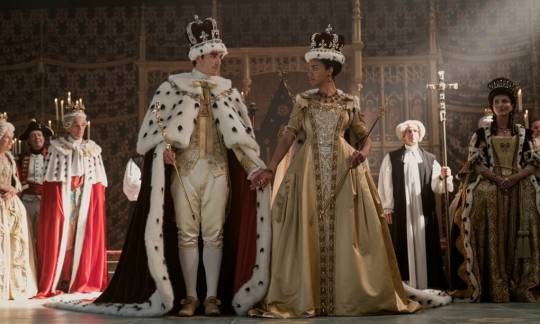
Coronations are the ceremony in which your monarch is confirmed by church or state or the people by the bestowing of a crown and regalia and the taking of oaths. So how do we write them?
When does Coronation takes place?

A Coronation usually takes place some time after death of the previous monarch. Past coronations would take place mere weeks after the death of a monarch as it was essential that the monarch be crowned to confirm their legitimacy. Modern coronations would take place months after the death of a monarch. In this time period, the new monarch IS the monarch - just uncrowned. This does not effect their powers in any way.
What’s in a Coronation?
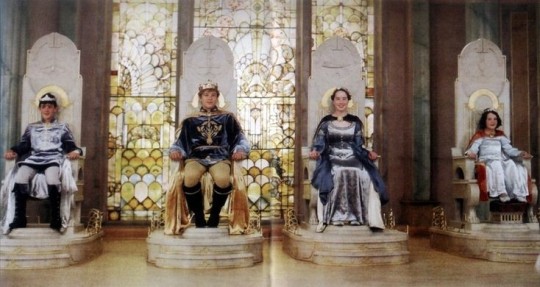
Coronations are usually very lavish affairs. These are not only just ceremonies, these are statements a sort of opening show to the monarch's reign. A Coronation will usually be accompanied by numerous parades, balls, pageants, military displays and concerts. It's usually framed as a celebration of the Royal family of the monarch or the nation as a whole. The population is expected to celebrate.
Who attends a Coronation?
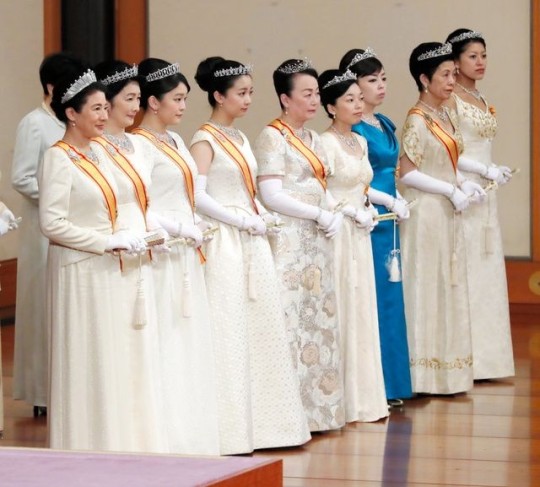
Coronations were big affairs. Many invitations would be sent out, inviting representatives from other nations, friends and allies, even uncertain friends and unfriendly nations. Other monarchs are generally not invited out of tradition but they will send heirs and relatives to represent them. Coronations were a display of wealth and power and it was in the monarch's best interest to get as many people there as possible. Coronations were also essential to monarchy for one very good reason: not only were you recognised by the state but it was a chance to accept fealty - promises of loyalty - from nobles. Many nobles from across the land would be invited to witness and then profess their loyalty to the Monarch.
What to Wear to a Coronation?
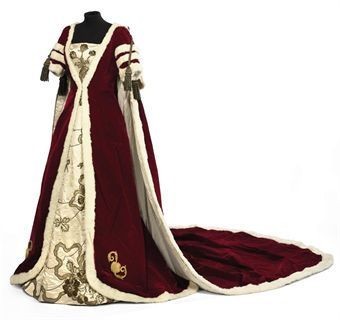
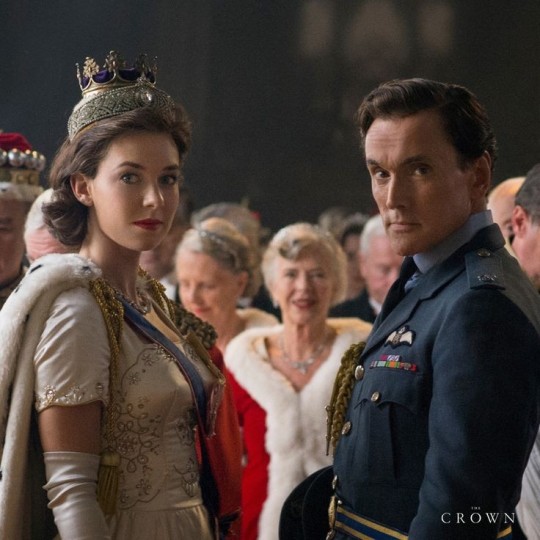
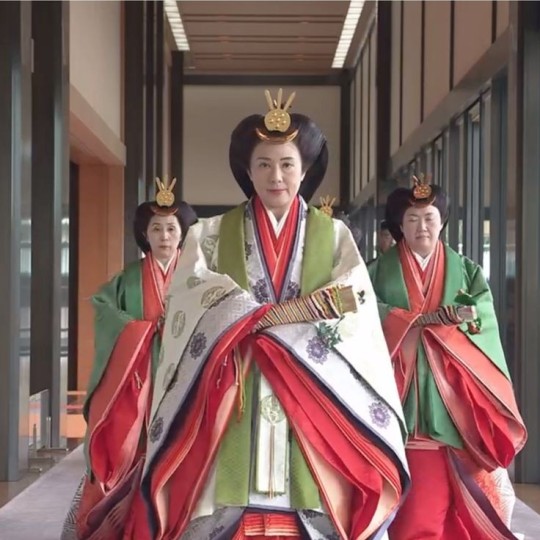
Coronations were meant to be pageants so everybody wore their very best clothes, jewels and put their best foot forward. Peers or nobles would wear red velvet robes (see above) over their clothes along with coronets (also see above) denoting rank. Traditional clothing would also be encouraged, the Japanese Imperial family often don traditional garments for their enthronements. The Royal family would wear military uniform or royal robes usually purple velvet rather than red trimmed with ermine. They would also wear coronets. The monarch would usually be the most expensive dressed, yet however this can also backfire. The monarch has to be modest yet also outdone everybody. George IV made the grave faux pas of spending a shit ton of money on his outfit for the coronation which he only wore the once. Most monarchs tend to have their Robes and clothes embroidered with emblems of the nation and to wear significant relics during the ceremony.
The Ceremony
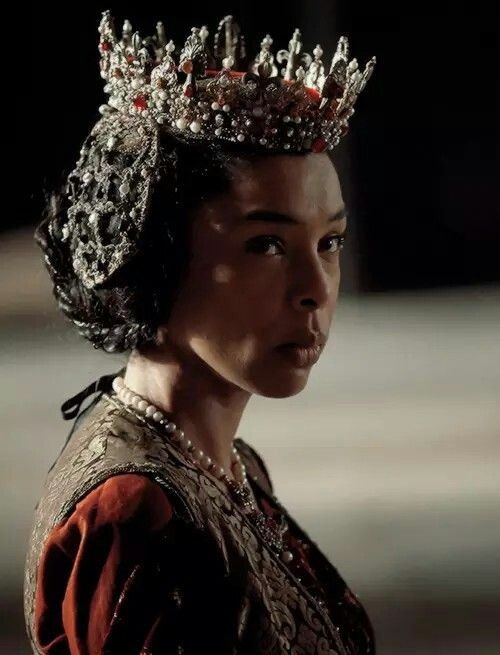
After a procession through the streets the monarch and/or their Consort arrive on the scene. They will be wrapped in red velvet Robes on their arrival and accompanied by pages or maids of honour who help carry the train of their Robes.
Before the monarch, selected peers will carry the regalia. These are the relics that are bestowed on the monarch throughout the ceremony. These usually include the crown itself, the sceptres, the coronation ring, the coronation Robes and an orb.
In some instances, the monarch would be presented to the assembled crowd at each Cardinal point - North, south, east, west and proclaimed the undoubted king/queen/sovereign. It is then the crowd issue an acceptance.
Monarchs would then be asked to take oaths by the figure ordaining them before the assembled crowd. These oaths would be one of service, something along the lines of promising to uphold law and tradition, being merciful, trying not to murder the peasants too much, keep their deity on side and try not to be too much of a failure.
Then monarch will sit on the throne and be anointed. During this part, they usually put a linen smock over their clothes to protect their finery. The anointing in Western culture is usually linked to Christianity, with the application of holy oil. However, the annointing can be replaced with a blessing in any other setting. During this part of the ceremony, the monarch and/or the Consort is shielded by a canopy of cloth of gold held aloft by high ranking nobles. This part of the ceremony is not to be witnessed by the crowd. It is sacred.
Then the monarch is wrapped in their new Robes. They are presented the regalia. The orb represents the monarch's power. The ring is symbolic of wedding oneself to duty. The sceptre is symbolic of power over governance. Once the monarch has been wrapped up and given these items, the Crown is then lowered onto their head. The crown is usually a jewel stubbed coronet fitted over a velvet cap and trimmed with ermine. There would be the monarch's crown and the Consort's crown (which is usually that much smaller). Around them, the nobility will place their coronets on simultaneously while the military give a gun salute.
After this, the Royal family and the peers would then come and kneel before the monarch, removing their coronets and making their oath of "I swear that I will pay true allegiance to Your Majesty, and to your heirs and successors according to law. So help me God." Once the path is made, they can step back and put their coronet back on.
Once homage is paid, the Consort would then be crowned if this is a married couple having their coronation. Consorts do not have to take an oath but they are given a coronation ring, a crown and sceptres.
Once everybody has made their oaths and the monarch can barely move under their Robes and regalia, it is time for the monarch to make a procession back through the streets - now a crowned monarch.
When Coronations go Wrong
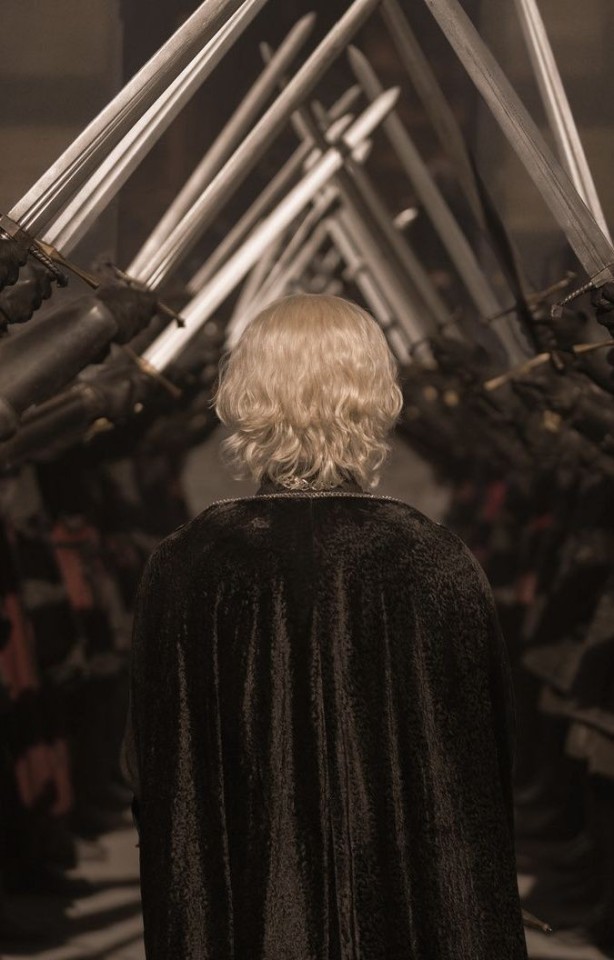
Like most ceremonies, things can go wrong at coronations. Most coronations go off without a hitch yet there are always downsides to a large, expensive ceremony of an unelected figurehead. Surprisingly.
Coronations are often long affairs. There are numerous historical accounts of peers and guests fainting from the exertion of standing in such heavy Robes. These Robes were not only deadly because of heat exhaustion but also their length. The elderly Lord Rolle actually fell down a flight of steps at Queen Victoria's coronation.
Many past coronations have failed due to poor planning. Nicholas II and his Consort Alexandra's coronation was a very lavish affair however due to terrible planning, a stampede occurred where thousands of Russian people where injured and killed. Despite the tragedy, the Couple did not visit the site or the injured, instead going to the French ambassador's ball on bad advice. History would remember him as Bloody Nicholas, made all the more bloody by the Revolution years after.
George IV, as per usual, caused consternation at his own coronation by constantly walking out from under his canopy which caused the nobles holding it to speed up making it all look rather silly.
Guestlists are often contentious points. It is very important not to jar international relations by snubbing foreign powers. While some of the nobles are invited, it is usually expected that the crown will invite representatives from all nations. If invitations are not issued, it can lead to issues. The Royal family is nearly always invited in its entirety even despite criminal activity (fuck you Andrew) but sometimes snubs are issued. Caroline of Brunswick, the rightful Queen Consort, was actually barred from being crowned by her husband. Its rumoured that her hammering on the door could be heard throughout George IV's coronation. Edward VIII, the King who abdicated over his love for Wallis Simpson, was not invited to either his brother's subsequent coronation or his niece's due to the optics of him being a former king and his rumoured ties to Britain's enemies.
Queen Victoria's coronation got off to a very bad start since the coronation ring had been made too small and then shoved onto the wrong ring. Victoria wrote in her diary that she had to rest her hand in ice for the rest of the day.
Coronations are framed as ceremonies of celebrations and national might and while that may be their intention, they are very often, rightly, subject to criticism. Coronations are widely expensive and very often are a display out outdated or unpopular ideals especially modern coronations. In a post WWI world the time of difference is now over and the media rightly critises such an expensive and outdated ceremony. Many monarchies have hastened to modernise to keep up with the new world, cutting down the budgets and revamping the ceremonies. The Swedish monarchs are no longer crowned but instead invested through an oath and sitting on their famous Silver Throne. However, many feel that coronations are becoming a thing of the past and may not be seen in the future.
#Fantasty guide to a Coronation#Coronations#Writing coronations#Writing royalty#Fantasy Guide#writeblr#writing resources#writing reference#writing advice#ask answered questions#writing advice writing resources#writing reference writing resources#Nobles#Nobility#Writing help#coronets
903 notes
·
View notes
Note
What do you think Anne Boleyn's wedding dress was like? I know the wedding was secret and that's why there are no reports, but Anne was a woman who loved fashion, well known for her style. Was it black, blue, white or another colour? The fabric and the wedding dresses?
hi, thank you for this interesting question!
to the best of my knowledge, you are correct - there are no records describing her gown, as it was a secret ceremony. we also know white wedding gowns were popularised after Queen Victoria's wedding, therefore, there was no 'traditional' wedding gown colour during this period. but, we can look at other surviving records, such as the mary's and their wedding gowns:
mary tudor, queen of france, wore white and gold
mary i of england may have worn purple and gold
mary, queen of scots, wore a gown "whiter than the lily"
what about anne's wardrobe as queen?
during her coronation procession, "she was dressed in filmy white, with a coronet of gold." (Ives)
during her actual coronation, she was dressed in "coronation robes of purple velvet, furred with ermine, with the gold coronet." (Ives)
"...eve of Easter Day 1533, Anne went to mass as queen...wearing a pleated gown of cloth of gold." (Ives)
so, what do I think she wore? i think she may have worn a french-styled gown (as she was deeply influenced by french fashion). the gown might have been white and gold, with some purple to show her newly evaluated status (as purple was the colour of royalty). materials wise, i think cloth of gold, satin, damask gold, ermine fur, and silk. but, it is also highly plausible she wore a simple gown as it was a secret ceremony.
though black was not the colour of mourning during the tudor period, i still cannot picture anne wearing black on her wedding day, or blue. i think red and purple would have been more likely.
(note: this is purely my opinion. we can never know for sure, we can only speculate!)
22 notes
·
View notes
Text

Javier Zurita Wildlife Photography
Velvet-purple Coronet, photo taken in
PH Mistrató-Colombia
34 notes
·
View notes
Text
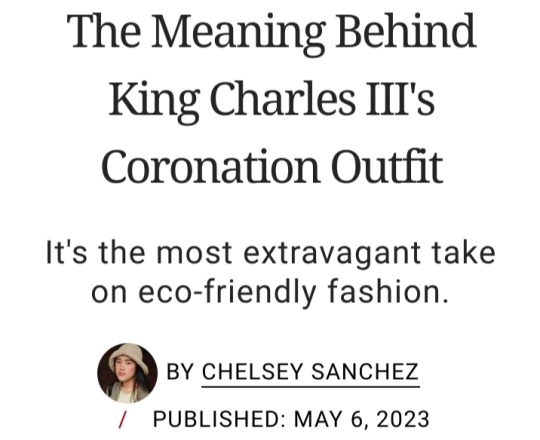
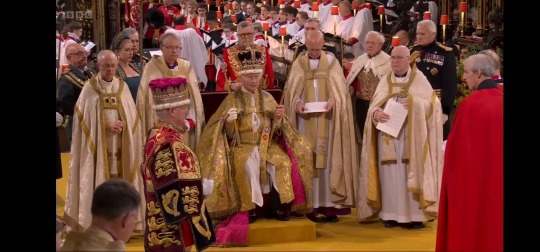
It's no surprise that King Charles III kept sustainability in mind when choosing what to wear on the day of his coronation.
Considering the monarch's lifelong passion for protecting the environment, it's natural that he would choose to make some eco-friendly sartorial choices.
Eco-friendly or not, the king's coronation day look was far from plain.
Upon arrival and departure, Charles wore two different grand robes, per royal tradition.
During the ceremony, King Charles III reused golden vestments, which have been worn for nearly every coronation since 1821, including the Colobium Sindonis, the Supertunica, the Imperial Mantle, the Coronation Sword Belt, and the Coronation Glove.
Buckingham Palace notes that "it is customary for the Supertunica and the Imperial Mantle to be reused, but the reuse of the other objects were made "in the interests of sustainability and efficiency."
Ahead, we break down the different parts of the king's coronation look.
The Robe of State
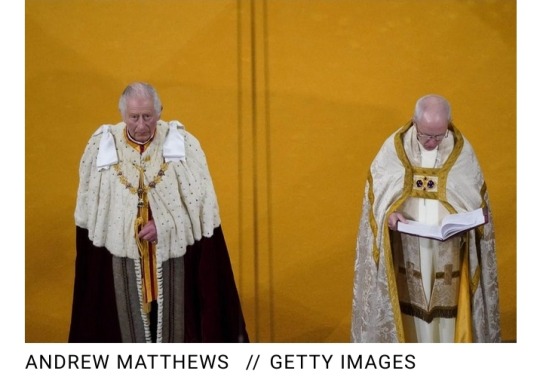
This magnificent crimson velvet robe was originally worn during King George VI's 1937 coronation.
It has since been conserved by the Royal School of Needlework and Ede and Ravenscroft.
The Colobium Sindonis
(Latin for "shroud tunic")
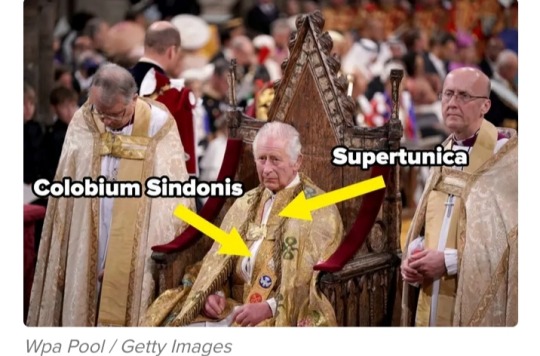
📷: via Buzzfeed
This piece appears as a white linen tunic with a collar fastened with a single button, fashioned after a priest's alb.
This particular piece of clothing has a sentimental meaning to Charles, as it was previously worn by his grandfather, George VI, during his 1937 coronation.
The Supertunica

This sleeved gold coat was originally made in 1911 for George V's coronation.
George VI and Queen Elizabeth II subsequently wore it at their own crowning ceremonies.
Though it is a relatively modern piece compared to other coronation regalia, it is designed in the same style as coats from medieval coronations, which is in turn influenced by priestly and religious vestments.
This Supertunica features goldwork techniques and embroidery, which was originally completed in 1911 by the Ladies Work Society.
The Imperial Mantle
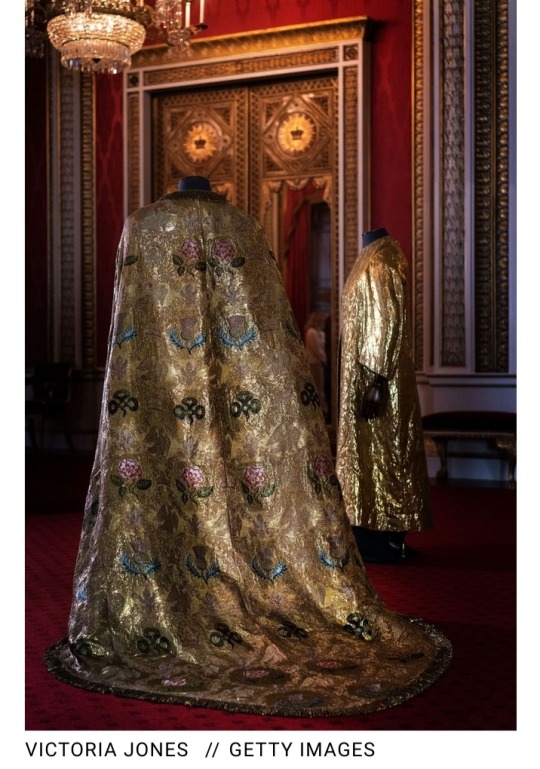
Worn over the Supertunica, the Imperial Mantle appears like a robe.
It's composed of cloth of gold, gold, silver and silk thread, silk, gold bullion fringe, and a gold clasp.
Additionally, symbolic shapes cover the surface of the Imperial Mantle, including roses, thistles, shamrocks, crowns, eagles, and fleurs-de-lis.
This piece was originally created for George IV's 1821 coronation.
It is the oldest amongst the coronation vestments.
The Coronation Sword Belt

Also known as the Girdle, the Coronation Sword Belt wraps around the Supertunica, with the Jewelled Sword of Offering then fastened at the monarch's waist.
Traditionally, this piece is made anew for each coronation, but Charles has instead chosen to reuse the same Sword Belt that his grandfather, George VI, wore during his 1937 ceremony.
This one features cloth of gold, red silk, and a gold buckle and clip.
The Coronation Glove

The Coronation Glove, also known as the gauntlet, is worn on the monarch's right hand to hold the Sovereign's Sceptre during the moment he is crowned.
Like the Coronation Sword Belt, Charles chose to reuse the hand piece that his grandfather, George VI, wore during his own coronation in 1937, rather than have one made entirely new.
This piece is made up of white leather and further features gilt metal thread embroidery depicting the national emblems of the Tudor Rose, thistle, shamrock, oak leaves, and acorns.
On the back of the glove's hand, there is an embroidered ducal coronet in red velvet above the coat of arms of the family of the Dukes of Newcastle.
The Robe of Estate

To leave Westminster Abbey, Charles put on this purple silk velvet robe that was, again, once worn by George VI. It includes elegant gold embroidery.
#King Charles III#Coronation Service 2023#Coronation 2023#British Royal Family#Coronation Outfit#The Robe of State#The Colobium Sindonis#The Supertunica#The Imperial Mantle#The Coronation Sword Belt#The Coronation Glove#Girdle#Gauntlet#Jewelled Sword of Offering#Sovereign's Sceptre#Royal School of Needlework#Ede and Ravenscroft#Ladies Work Society#George IV#George V#George VI#Elizabeth II
8 notes
·
View notes
Text

Velvet-purple Coronet (Boissonneaua jardini) © e-Ken.jpg
0 notes
Text
Joyas Voladoras
By Brian Doyle | June 12, 2012
*this was sent to me following a transcendental haircut hour with poet Marie Howe who initially read the essay out loud to me while I pushed her curls into a flow, misty eyes for both of us
Consider the hummingbird for a long moment. A hummingbird’s heart beats ten times a second. A hummingbird’s heart is the size of a pencil eraser. A hummingbird’s heart is a lot of the hummingbird. Joyas voladoras, flying jewels, the first white explorers in the Americas called them, and the white men had never seen such creatures, for hummingbirds came into the world only in the Americas, nowhere else in the universe, more than three hundred species of them whirring and zooming and nectaring in hummer time zones nine times removed from ours, their hearts hammering faster than we could clearly hear if we pressed our elephantine ears to their infinitesimal chests.
Each one visits a thousand flowers a day. They can dive at sixty miles an hour. They can fly backwards. They can fly more than five hundred miles without pausing to rest. But when they rest they come close to death: on frigid nights, or when they are starving, they retreat into torpor, their metabolic rate slowing to a fifteenth of their normal sleep rate, their hearts sludging nearly to a halt, barely beating, and if they are not soon warmed, if they do not soon find that which is sweet, their hearts grow cold, and they cease to be. Consider for a moment those hummingbirds who did not open their eyes again today, this very day, in the Americas: bearded helmet-crests and booted racket-tails, violet-tailed sylphs and violet-capped woodnymphs, crimson topazes and purple-crowned fairies, red-tailed comets and amethyst woodstars, rainbow-bearded thornbills and glittering-bellied emeralds, velvet-purple coronets and golden-bellied star-frontlets, fiery-tailed awlbills and Andean hillstars, spatuletails and pufflegs, each the most amazing thing you have never seen, each thunderous wild heart the size of an infant’s fingernail, each mad heart silent, a brilliant music stilled.
Hummingbirds, like all flying birds but more so, have incredible enormous immense ferocious metabolisms. To drive those metabolisms they have race-car hearts that eat oxygen at an eye-popping rate. Their hearts are built of thinner, leaner fibers than ours. Their arteries are stiffer and more taut. They have more mitochondria in their heart muscles—anything to gulp more oxygen. Their hearts are stripped to the skin for the war against gravity and inertia, the mad search for food, the insane idea of flight. The price of their ambition is a life closer to death; they suffer more heart attacks and aneurysms and ruptures than any other living creature. It’s expensive to fly. You burn out. You fry the machine. You melt the engine. Every creature on earth has approximately two billion heartbeats to spend in a lifetime. You can spend them slowly, like a tortoise and live to be two hundred years old, or you can spend them fast, like a hummingbird, and live to be two years old.
The biggest heart in the world is inside the blue whale. It weighs more than seven tons. It’s as big as a room. It is a room, with four chambers. A child could walk around it, head high, bending only to step through the valves. The valves are as big as the swinging doors in a saloon. This house of a heart drives a creature a hundred feet long. When this creature is born it is twenty feet long and weighs four tons. It is waaaaay bigger than your car. It drinks a hundred gallons of milk from its mama every day and gains two hundred pounds a day, and when it is seven or eight years old it endures an unimaginable puberty and then it essentially disappears from human ken, for next to nothing is known of the the mating habits, travel patterns, diet, social life, language, social structure, diseases, spirituality, wars, stories, despairs and arts of the blue whale. There are perhaps ten thousand blue whales in the world, living in every ocean on earth, and of the largest animal who ever lived we know nearly nothing. But we know this: the animals with the largest hearts in the world generally travel in pairs, and their penetrating moaning cries, their piercing yearning tongue, can be heard underwater for miles and miles.
Mammals and birds have hearts with four chambers. Reptiles and turtles have hearts with three chambers. Fish have hearts with two chambers. Insects and mollusks have hearts with one chamber. Worms have hearts with one chamber, although they may have as many as eleven single-chambered hearts. Unicellular bacteria have no hearts at all; but even they have fluid eternally in motion, washing from one side of the cell to the other, swirling and whirling. No living being is without interior liquid motion. We all churn inside.
So much held in a heart in a lifetime. So much held in a heart in a day, an hour, a moment. We are utterly open with no one in the end—not mother and father, not wife or husband, not lover, not child, not friend. We open windows to each but we live alone in the house of the heart. Perhaps we must. Perhaps we could not bear to be so naked, for fear of a constantly harrowed heart. When young we think there will come one person who will savor and sustain us always; when we are older we know this is the dream of a child, that all hearts finally are bruised and scarred, scored and torn, repaired by time and will, patched by force of character, yet fragile and rickety forevermore, no matter how ferocious the defense and how many bricks you bring to the wall. You can brick up your heart as stout and tight and hard and cold and impregnable as you possibly can and down it comes in an instant, felled by a woman’s second glance, a child’s apple breath, the shatter of glass in the road, the words I have something to tell you, a cat with a broken spine dragging itself into the forest to die, the brush of your mother’s papery ancient hand in the thicket of your hair, the memory of your father’s voice early in the morning echoing from the kitchen where he is making pancakes for his children.
———
0 notes
Text
[ID: A graphic with birds flying through the sky listing the birds under the caption, "Birdtober" List goes, "1. Willow ptarmigan 2. Stephanie's Astrapia 3. American kestrel 4. Wilson's bird-of-paradise 5. Magnificent frigatebird 6. Nicobar pigeon 7. Bearded reedling 8. Catalina macaw 9. Eurasian jay 10. Red-shouldered hawk 11. Velvet-purple coronet 12. Tufted titmouse 13. Superb lyrebird 14. Japanese pygmy woodpecker 15. Belted kingfisher 16. Black-faced hawk 17. Exclamatory paradise whydah 18. Chukar 19. King-of-saxony bird-of-paradise 20. Osprey 21. Adelie Penguin 22. Cerulean-capped manakin 23. Crested guan 24. Balck-crowned night heron 25. Stellar's jay 26. Tit berrypecker 27. Northern carmine bee-eater 28. Baltimore oriole 29. Evening grosbeak 30. Steel-blue flycatcher 31. Kakapo." End ID]

Taking on @thelocal-idot 's birdtober 2024 challenge this year because I like birds
Prompt list below the cut vv

180 notes
·
View notes
Video
Velvet-purple Coronet (Boissonneaua jardini) by Scott Olmstead Via Flickr: Recinto 23 de Junio, Pichincha, Ecuador | June 27, 2024
#Velvet-purple Coronet#Trochilidae#colibrí#quinde#beija-flor#Boissonneaua jardini#Coronita Terciopelo#hummingbird#nature#naturaleza#wildlife#vida silvestre#coloful#dazzling#iridescent#iridescence#siete colores#flickr
5 notes
·
View notes
Text




What Is the Essence of Iridescence? Ask a Hummingbird
Velvet-purple Coronet, Fiery-throated Hummingbird, Gould’s Jewelfront, and Rainbow Starfrontlet.
#birds#hummingbirds#velvet-purple coronet#firey-throated hummingbird#gould’s jewelfront#rainbow starfrontlet
11 notes
·
View notes
Text

Velvet-purple Coronet (Boissonneaua jardini), family Trochilidae, order Apodiformes, Ecuador
photograph by Jorge Luis Cruz Alcivar
#coronet#hummingbird#boissonneaua#trochilidae#apodiformes#bird#ornithology#animals#nature#south america
1K notes
·
View notes
